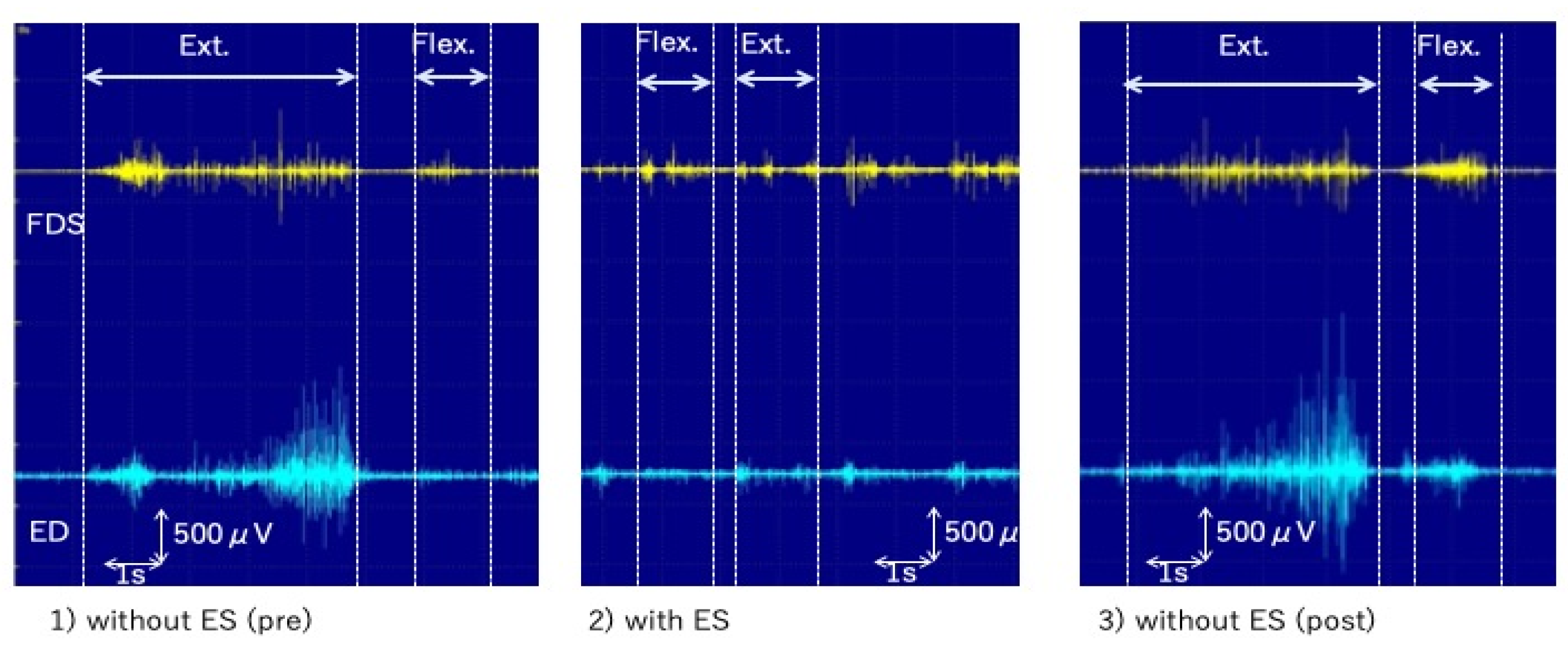Electrically Induced Sensory Trick in a Patient with Musician’s Dystonia: A Case Report
Abstract
1. Introduction
2. Case Presentation
3. Discussion
4. Conclusions
Supplementary Materials
Author Contributions
Funding
Institutional Review Board Statement
Informed Consent Statement
Data Availability Statement
Conflicts of Interest
References
- Ramos, V.F.; Karp, B.I.; Hallett, M. Tricks in dystonia: Ordering the complexity. J. Neurol. Neurosurg. Psychiatry 2014, 85, 987–993. [Google Scholar] [CrossRef] [PubMed]
- Lorenzano, D.; Tansley, S.; Ezra, D.G. Sensory trick frames: A new device for blepharospasm patients. J. Mov. Disord. 2019, 12, 22–26. [Google Scholar] [CrossRef] [PubMed]
- Asahi, T.; Nakamura, T.; Sato, M.; Kon, Y.; Kajimoto, H.; Sato, S. The hanger reflex: An inexpensive and non-invasive therapeutic modality for dystonia and neurological disorders. Neurol. Med. Chir. 2020, 60, 525–530. [Google Scholar] [CrossRef]
- Dagostino, S.; Ercoli, T.; Gigante, A.F.; Pellicciari, R.; Fadda, L.; Defazio, G. Sensory trick in upper limb dystonia. Park. Relat. Disord. 2019, 63, 221–223. [Google Scholar] [CrossRef] [PubMed]
- Defazio, G.; Ercoli, T.; Erro, R.; Pellicciari, R.; Mascia, M.M.; Fabbrini, G.; Albanese, A.; Lalli, S.; Eleopra, R.; Barone, P.; et al. Idiopathic non-task-specific upper limb dystonia, a neglected form of dystonia. Mov. Disord. 2020, 35, 2038–2045. [Google Scholar] [CrossRef]
- Konczak, J.; Abbruzzese, G. Focal dystonia in musicians: Linking motor symptoms to somatosensory dysfunction. Front. Hum. Neurosci. 2013, 7, 297. [Google Scholar] [CrossRef]
- Altenmüller, E.; Baur, V.; Hofmann, A.; Lim, V.K.; Jabusch, H.C. Musician’s cramp as manifestation of maladaptive brain plasticity: Arguments from instrumental differences. Ann. NY Acad. Sci. 2012, 1252, 259–265. [Google Scholar] [CrossRef]
- Furuya, S.; Altenmuller, E. Acquisition and reacquisition of motor coordination in musicians. Ann. NY Acad. Sci. 2015, 1337, 118–124. [Google Scholar] [CrossRef]
- Conti, A.M.; Pullman, S.; Frucht, S.J. The hand that has forgotten its cunning--lessons from musicians’ hand dystonia. Mov. Disord. 2008, 23, 1398–1406. [Google Scholar] [CrossRef]
- Japanese Society of Neurology. Practical Guideline for Dystonia 2018; Nankodo Co., Ltd.: Tokyo, Japan, 2018. [Google Scholar]
- Fung, V.S.; Jinnah, H.A.; Bhatia, K.; Vidailhet, M. Assessment of patients with isolated or combined dystonia: An update on dystonia syndromes. Mov. Disord. 2013, 28, 889–898. [Google Scholar] [CrossRef]
- Naumann, M.; Magyar-Lehmann, S.; Reiners, K.; Erbguth, F.; Leenders, K.L. Sensory tricks in cervical dystonia: Perceptual dysbalance of parietal cortex modulates frontal motor programming. Ann. Neurol. 2000, 47, 322–328. [Google Scholar] [CrossRef] [PubMed]
- Cho, H.J.; Waugh, R.; Wu, T.; Panyakaew, P.; Mente, K.; Urbano, D.; Hallett, M.; Horovitz, S.G. Role of supplementary motor area in cervical dystonia and sensory tricks. Sci. Rep. 2022, 12, 21206. [Google Scholar] [CrossRef]
- Erro, R.; Rocchi, L.; Antelmi, E.; Liguori, R.; Tinazzi, M.; Berardelli, A.; Rothwell, J.; Bhatia, K.P. High frequency somatosensory stimulation in dystonia: Evidence fordefective inhibitory plasticity. Mov. Disord. 2018, 33, 1902–1909. [Google Scholar] [CrossRef] [PubMed]
- Erro, R.; Antelmi, E.; Bhatia, K.P.; Latorre, A.; Tinazzi, M.; Berardelli, A.; Rothwell, J.; Rocchi, L. Reversal of temporal discrimination in cervical dystonia after low-frequency sensory stimulation. Mov. Disord. 2021, 36, 761–766. [Google Scholar] [CrossRef] [PubMed]
- Latorre, A.; Cocco, A.; Bhatia, K.P.; Erro, R.; Antelmi, E.; Conte, A.; Rothwell, J.C.; Rocchi, L. Defective somatosensory inhibition and plasticity are not required to develop dystonia. Mov. Disord. 2021, 36, 1015–1521. [Google Scholar] [CrossRef]
- Conte, A.; Rocchi, L.; Latorre, A.; Belvisi, D.; Rothwell, J.C.; Berardelli, A. Ten-year reflections on the neurophysiological abnormalities of focal dystonias in humans. Mov. Disord. 2019, 34, 1616–1628. [Google Scholar] [CrossRef]
- Latorre, A.; Rocchi, L.; Bhatia, K.P. Delineating the electrophysiological signature of dystonia. Exp. Brain Res. 2020, 238, 1685–1692. [Google Scholar] [CrossRef]
- Murase, N.; Kaji, R.; Shimazu, H.; Katayama-Hirota, M.; Ikeda, A.; Kohara, N.; Kimura, J.; Shibasaki, H.; Rothwell, J.C. Abnormal premovement gating of somatosensory input in writer’s cramp. Brain 2000, 123, 1813–1829. [Google Scholar] [CrossRef]
- Pujol, J.; Roset-Llobet, J.; Rosinés-Cubells, D.; Deus, J.; Narberhaus, B.; Valls-Solé, J.; Capdevila, A.; Pascual-Leone, A. Brain cortical activation during guitar-induced hand dystonia studied by functional MRI. Neuroimage 2000, 12, 257–267. [Google Scholar] [CrossRef]
- Leis, A.A.; Dimitrijevic, M.R.; Delapasse, J.S.; Sharkey, P.C. Modification of cervical dystonia by selective sensory stimulation. J. Neurol. Sci. 1992, 110, 79–89. [Google Scholar] [CrossRef]
- Monte-Silva, K.; Piscitelli, D.; Norouzi-Gheidari, N.; Batalla, M.A.P.; Archambault, P.; Levin, M.F. Electromyogram-related neuromuscular electrical stimulation for restoring wrist and hand movement in poststroke hemiplegia: A systematic review and meta-analysis. Neurorehabil. Neural Repair 2019, 33, 96–111. [Google Scholar] [CrossRef] [PubMed]
- Pasluosta, C.; Kiele, P.; Stieglitz, T. Paradigms for restoration of somatosensory feedback via stimulation of the peripheral nervous system. Clin. Neurophysiol. 2018, 129, 851–862. [Google Scholar] [CrossRef] [PubMed]

Disclaimer/Publisher’s Note: The statements, opinions and data contained in all publications are solely those of the individual author(s) and contributor(s) and not of MDPI and/or the editor(s). MDPI and/or the editor(s) disclaim responsibility for any injury to people or property resulting from any ideas, methods, instructions or products referred to in the content. |
© 2023 by the authors. Licensee MDPI, Basel, Switzerland. This article is an open access article distributed under the terms and conditions of the Creative Commons Attribution (CC BY) license (https://creativecommons.org/licenses/by/4.0/).
Share and Cite
Nishida, D.; Mizuno, K.; Takahashi, O.; Liu, M.; Tsuji, T. Electrically Induced Sensory Trick in a Patient with Musician’s Dystonia: A Case Report. Brain Sci. 2023, 13, 223. https://doi.org/10.3390/brainsci13020223
Nishida D, Mizuno K, Takahashi O, Liu M, Tsuji T. Electrically Induced Sensory Trick in a Patient with Musician’s Dystonia: A Case Report. Brain Sciences. 2023; 13(2):223. https://doi.org/10.3390/brainsci13020223
Chicago/Turabian StyleNishida, Daisuke, Katsuhiro Mizuno, Osamu Takahashi, Meigen Liu, and Tetsuya Tsuji. 2023. "Electrically Induced Sensory Trick in a Patient with Musician’s Dystonia: A Case Report" Brain Sciences 13, no. 2: 223. https://doi.org/10.3390/brainsci13020223
APA StyleNishida, D., Mizuno, K., Takahashi, O., Liu, M., & Tsuji, T. (2023). Electrically Induced Sensory Trick in a Patient with Musician’s Dystonia: A Case Report. Brain Sciences, 13(2), 223. https://doi.org/10.3390/brainsci13020223





